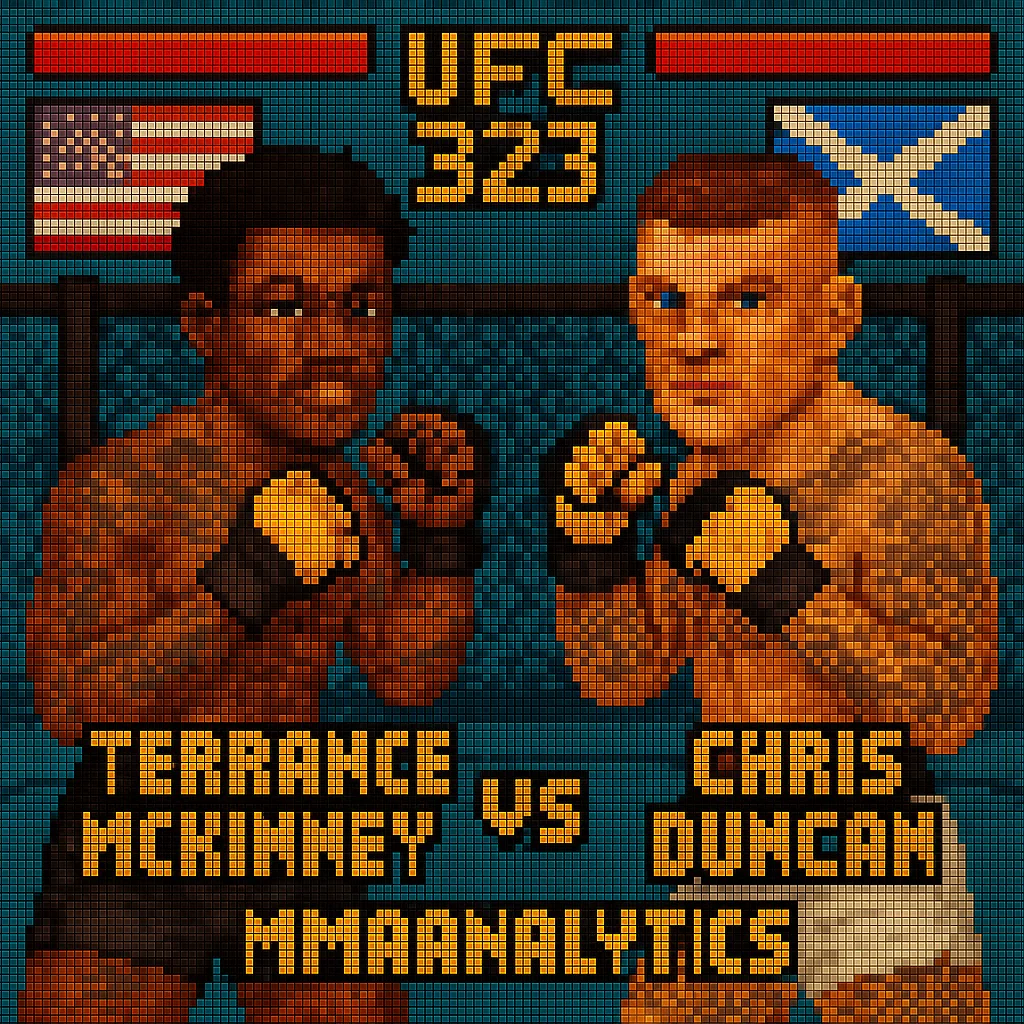Chris Duncan vs Terrance McKinney
Men's Lightweight Bout • UFC 323
Saturday, December 6, 2025

Explore Detailed Fighter Profiles
Click on either the fighter's name or profile image for each fighter to access comprehensive UFC statistics including striking metrics, grappling data, clinch performance, complete fight history, offensive & defensive analytics, and round-by-round breakdowns.
Chris Duncan
Fighter Metrics
Victory Methods
Win Round Distribution
Last 5 Fights
| Date | Opponent | Result | Method |
|---|---|---|---|
| 2025-08-02 | Mateusz Rębecki | W | Decision - Unanimous (R3, 5:00) |
| 2025-03-22 | Jordan Vucenic | W | Submission - Guillotine Choke (R2, 3:42) |
| 2024-09-28 | Bolaji Oki | W | Submission - Guillotine Choke (R1, 3:34) |
| 2024-02-24 | Manuel Torres | L | Submission - Rear Naked Choke (R1, 1:46) |
| 2023-07-22 | Yanal Ashmouz | W | Decision - Unanimous (R3, 5:00) |
Terrance McKinney
Fighter Metrics
Victory Methods
Win Round Distribution
Last 5 Fights
| Date | Opponent | Result | Method |
|---|---|---|---|
| 2025-06-28 | Viacheslav Borshchev | W | Submission - Guillotine Choke (R1, 0:55) |
| 2025-02-01 | Damir Hadzovic | W | KO/TKO - Punches from Back Control (R1, 2:01) |
| 2024-05-11 | Esteban Ribovics | L | KO/TKO - Head Kick (R1, 0:37) |
| 2023-10-14 | Brendon Marotte | W | KO/TKO - Knee in Clinch (R1, 0:20) |
| 2023-08-12 | Mike Breeden | W | KO/TKO - Punches (R1, 1:25) |
📊 Technical Radar Comparison
Legend & Notes
- • SLpM, TD15, Sub/15 are normalized to 0–100 for plotting.
- • Percent metrics (StrAcc, StrDef, TDAcc, TDDef) are raw %.
- • Tooltip shows true raw values with units.
- • Colors: Blue = Chris Duncan, Red = Terrance McKinney.
📊 Detailed Statistical Comparison
Technical Score
Cardio Score
Overall Rating
🥊 Fight Analysis Breakdown
🏆 Chris Duncan Key Advantages
Applies steady takedown pressure (4.1 vs 3.59 per 15 min) to slow early chaos and bank control time. His wrestling-based approach becomes increasingly effective as rounds progress, allowing him to dictate pace and neutralize McKinney's explosive striking.
Demonstrated 15-minute composure vs elite pressure (Rębecki UD), trending toward late-round control. His cardio advantage (avg 9:40 fight time vs McKinney's 2:25) signals an ability to maintain output through championship rounds.
Increasing decision share with improved round-winning habits; mixes clinch, fence work, and volume. His tactical evolution shows better fight IQ, particularly in managing exchanges and leveraging positional control to accumulate points.
⚠️ Unfavorable Scenarios
📋 Likely Gameplan
🚀 Terrance McKinney Key Advantages
Relentless early surge with clean power and snap submissions. McKinney's 100% UFC finish rate combines technical striking (56% accuracy) with opportunistic submission instincts.
Instant front-headlock danger and transition chokes. McKinney's sub rate highlights his guillotine proficiency, particularly lethal against wrestlers like Duncan.
Controls first contact with longer arms and lands cleanly at high clip (56% accuracy). This edge is amplified in the 30-foot cage.
⚠️ Unfavorable Scenarios
📋 Likely Gameplan
🎯 Fight Prediction Analysis
Data-driven prediction model based on statistical analysis
📊Detailed Analysis Summary
🏆Championship Dynamics
Big 30-foot cage + 3 rounds set a pace-versus-power duel. Duncan's recent full-distance win confirms composure, while McKinney brings high-volatility starts. Space reduces clinch collisions early but rewards structured round-winning later.
🎯Technical Breakdown
McKinney leads raw tools (SLpM, Acc, TDD, Subs), an early-finish arsenal. Duncan balances with endurance and decision equity. The statistical disparity reveals two fundamentally different fighters: McKinney excels in explosive metrics, Duncan dominates sustainability.
⚡Key Battle Areas
R1 entry management (McKinney blitz vs Duncan guard); fence sequences where Duncan can slow tempo; final minutes where cardio matters. Front-headlock exchanges favor McKinney; long fence rides favor Duncan.
🏁Final Prediction
Slight lean to Chris Duncan by Decision (55-45), contingent on surviving the early sprint. McKinney remains a live threat with real first-round equity. If this reaches round 3, Duncan likely wins; if it ends early, McKinney gets his hand raised.
💰 Betting Analysis: Model vs Market
Detailed value assessment in the betting market
📊Market Odds
🤖Analytical Model
Model Props (Fair Odds)
💎Value Opportunities
MAXIMUM VALUE
Model ITD: 42%
GOOD VALUE
Model: 35%
SLIGHT VALUE
Model: ~57%
🎯 Comprehensive Probabilistic Analysis
100 hypothetical fight simulation based on statistical data
🏆Outcome Distribution - Chris Duncan
💥Outcome Distribution - Terrance McKinney
🎯 Final Confidence Assessment
Confidence level and risk considerations
Confidence Level
Balanced edge with early volatility risk.
✅Supporting Factors
- • Proven 15-minute output vs Rębecki
- • Higher decision equity in large cage
- • Wrestling volume to slow scrambles
- • Composure in extended exchanges
⚠️Risk Factors
- • McKinney’s explosive R1 profile
- • High submission attempt rate
- • +2" reach with clean striking
- • Lightweight volatility
